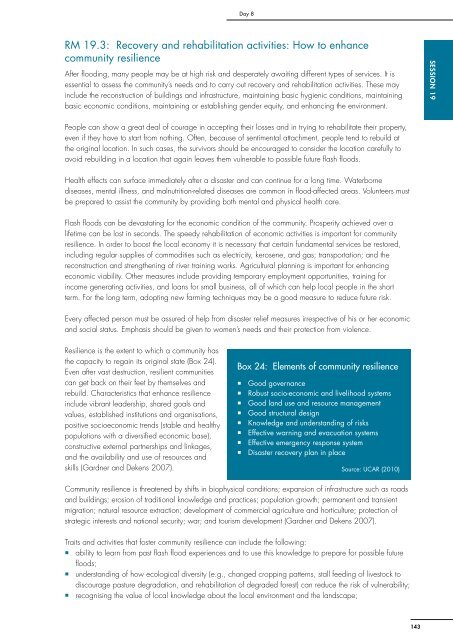Flash Flood Risk Management â A Training of Trainers ... - ReliefWeb
Flash Flood Risk Management â A Training of Trainers ... - ReliefWeb
Flash Flood Risk Management â A Training of Trainers ... - ReliefWeb
Create successful ePaper yourself
Turn your PDF publications into a flip-book with our unique Google optimized e-Paper software.
Day 8<br />
RM 19.3: Recovery and rehabilitation activities: How to enhance<br />
community resilience<br />
After flooding, many people may be at high risk and desperately awaiting different types <strong>of</strong> services. It is<br />
essential to assess the community’s needs and to carry out recovery and rehabilitation activities. These may<br />
include the reconstruction <strong>of</strong> buildings and infrastructure, maintaining basic hygienic conditions, maintaining<br />
basic economic conditions, maintaining or establishing gender equity, and enhancing the environment.<br />
Session 19<br />
People can show a great deal <strong>of</strong> courage in accepting their losses and in trying to rehabilitate their property,<br />
even if they have to start from nothing. Often, because <strong>of</strong> sentimental attachment, people tend to rebuild at<br />
the original location. In such cases, the survivors should be encouraged to consider the location carefully to<br />
avoid rebuilding in a location that again leaves them vulnerable to possible future flash floods.<br />
Health effects can surface immediately after a disaster and can continue for a long time. Waterborne<br />
diseases, mental illness, and malnutrition-related diseases are common in flood-affected areas. Volunteers must<br />
be prepared to assist the community by providing both mental and physical health care.<br />
<strong>Flash</strong> floods can be devastating for the economic condition <strong>of</strong> the community. Prosperity achieved over a<br />
lifetime can be lost in seconds. The speedy rehabilitation <strong>of</strong> economic activities is important for community<br />
resilience. In order to boost the local economy it is necessary that certain fundamental services be restored,<br />
including regular supplies <strong>of</strong> commodities such as electricity, kerosene, and gas; transportation; and the<br />
reconstruction and strengthening <strong>of</strong> river training works. Agricultural planning is important for enhancing<br />
economic viability. Other measures include providing temporary employment opportunities, training for<br />
income generating activities, and loans for small business, all <strong>of</strong> which can help local people in the short<br />
term. For the long term, adopting new farming techniques may be a good measure to reduce future risk.<br />
Every affected person must be assured <strong>of</strong> help from disaster relief measures irrespective <strong>of</strong> his or her economic<br />
and social status. Emphasis should be given to women’s needs and their protection from violence.<br />
Resilience is the extent to which a community has<br />
the capacity to regain its original state (Box 24).<br />
Even after vast destruction, resilient communities<br />
can get back on their feet by themselves and<br />
rebuild. Characteristics that enhance resilience<br />
include vibrant leadership, shared goals and<br />
values, established institutions and organisations,<br />
positive socioeconomic trends (stable and healthy<br />
populations with a diversified economic base),<br />
constructive external partnerships and linkages,<br />
and the availability and use <strong>of</strong> resources and<br />
skills (Gardner and Dekens 2007).<br />
Box 24: Elements <strong>of</strong> community resilience<br />
• Good governance<br />
• Robust socio-economic and livelihood systems<br />
• Good land use and resource management<br />
• Good structural design<br />
• Knowledge and understanding <strong>of</strong> risks<br />
• Effective warning and evacuation systems<br />
• Effective emergency response system<br />
• Disaster recovery plan in place<br />
Source: UCAR (2010)<br />
Community resilience is threatened by shifts in biophysical conditions; expansion <strong>of</strong> infrastructure such as roads<br />
and buildings; erosion <strong>of</strong> traditional knowledge and practices; population growth; permanent and transient<br />
migration; natural resource extraction; development <strong>of</strong> commercial agriculture and horticulture; protection <strong>of</strong><br />
strategic interests and national security; war; and tourism development (Gardner and Dekens 2007).<br />
Traits and activities that foster community resilience can include the following:<br />
• ability to learn from past flash flood experiences and to use this knowledge to prepare for possible future<br />
floods;<br />
• understanding <strong>of</strong> how ecological diversity (e.g., changed cropping patterns, stall feeding <strong>of</strong> livestock to<br />
discourage pasture degradation, and rehabilitation <strong>of</strong> degraded forest) can reduce the risk <strong>of</strong> vulnerability;<br />
• recognising the value <strong>of</strong> local knowledge about the local environment and the landscape;<br />
143

















